Special Report
Countries Where the Most People Have Died In Natural Disasters

Published:
Last Updated:

Over the past decade, natural disasters have killed an average of approximately 45,000 people each year, according to Our World in Data. The organization, which tracks earthquakes, volcanic activity, landslides, drought, wildfires, storms, and flooding across the globe, emphasizes the number varies annually based on how widespread the impact of a disaster (or disasters) is, the frequency, and severity of a disaster – or disasters – in any given year.
Throughout history, high death tolls followed droughts and floods. Today, single catastrophic events like earthquakes cause the most fatalities, like the massive Haitian earthquake in 2010. Low- to middle-income countries tend to be hardest hit when a natural disaster strikes due to less resilient infrastructure. See the places most vulnerable to disaster.
Sadly, floods and hurricanes still kill many thousands of people as the disasters described here show. Yet the absence of rain can also lead to droughts, leading to starvation and disease outbreaks in many countries, notably in Africa.
Scientists predict that climate change will increase the frequency and intensity of some natural disasters, which would cost more lives, destroy more property, and displace more people. Here are the worst climate-related disasters since 2010.
To determine the countries where the most people die due to natural disaster, 24/7 Wall St. reviewed data from the international disaster database EM-DAT, of the Centre for Research on the Epidemiology of Disasters. Countries were ranked based on the average annual number of deaths due to natural disaster per 1 million people since 1960.
Natural disasters include drought, earthquake, volcano, mass rock movement, storm, flood, epidemic, landside, wildfire, extreme temperature, fog, insect infestation, impact, animal accident, or glacial lake outburst. Population data used to adjust deaths per capita came from the World Bank. All other data is from EM-DAT.
Click here to see countries where the most people have died in natural disasters.
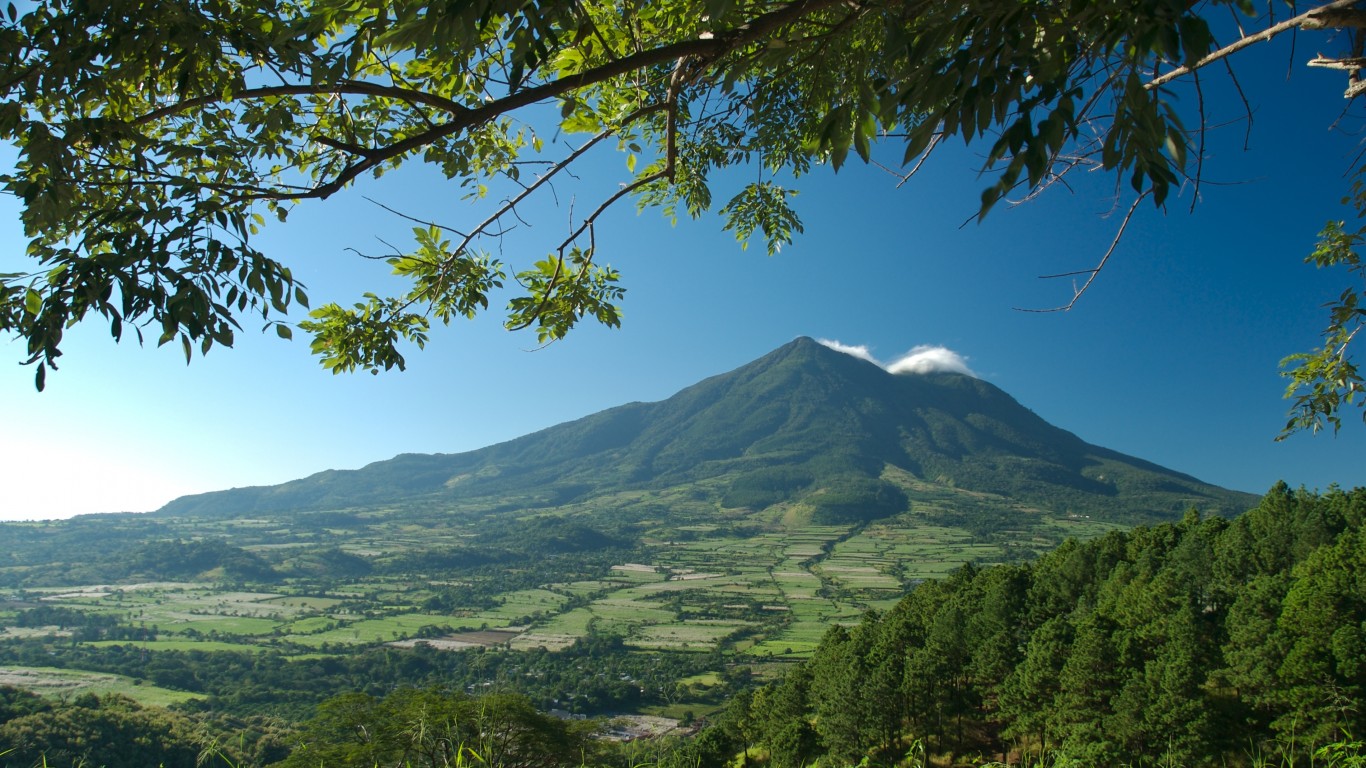
29. El Salvador
> Annual deaths due to natural disaster, 1960-2022: 14.7 per million
> Most common natural disaster: Storm (20 incidents since 1900)
> Deadliest disaster since 1900: June 1934 tropical cyclone (2,000 deaths)
> Total population: 6.5 million
The 1934 Central American Hurricane, also known as the El Salvador hurricane, struck the Central American country between June 5-8. The storm dumped 25 inches of rain in the region, causing 14 rivers in El Salvador to overflow. Most of the deaths occurred in the city San Salvador, where 2,000 reportedly perished.
[in-text-ad]
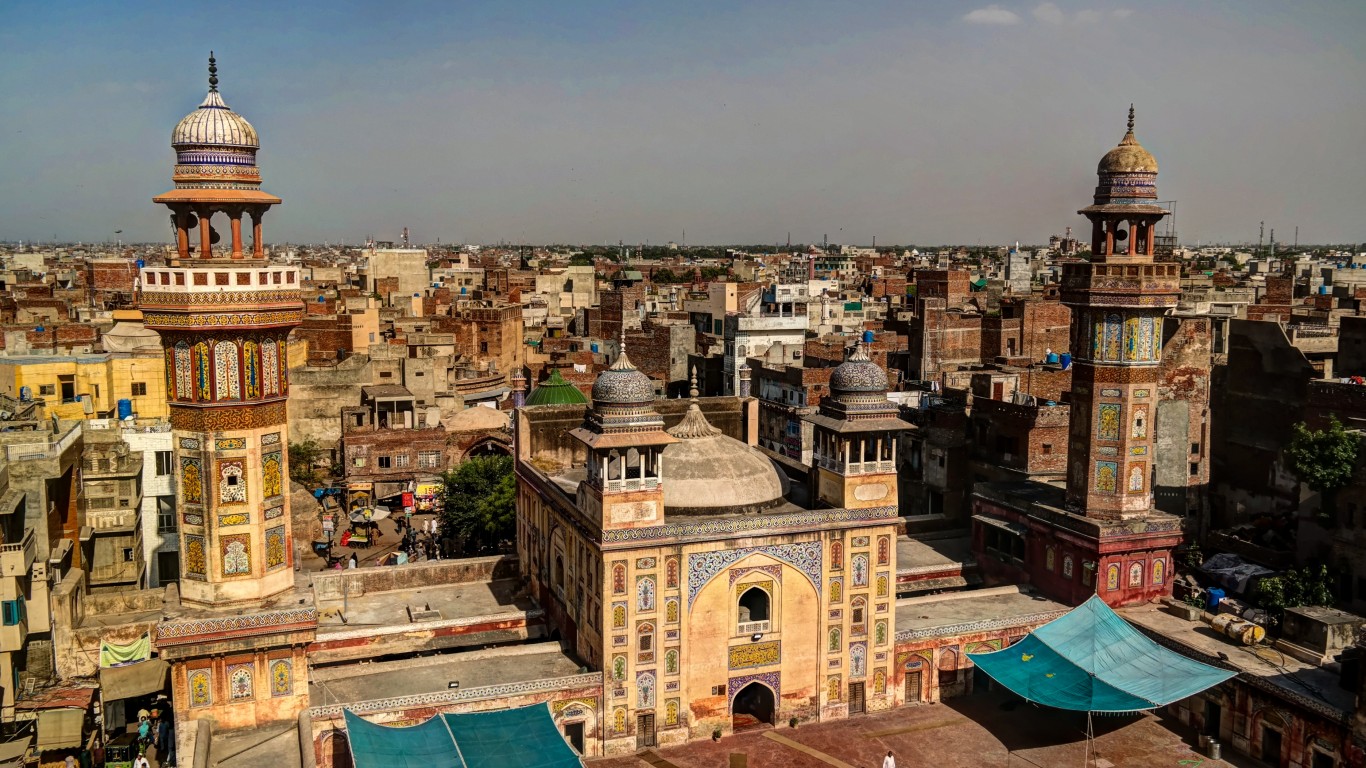
28. Pakistan
> Annual deaths due to natural disaster, 1960-2022: 15.3 per million
> Most common natural disaster: Flood (111 incidents since 1900)
> Deadliest disaster since 1900: October 2005 earthquake (73,338 deaths)
> Total population: 225.2 million
In October 2005, a 7.6 magnitude earthquake struck the Kashmir region, an area both India and Pakistan claim ownership. The territory sits between the Eurasian and Indian tectonic plates, making it a hotspot for seismic activity. Some towns were partially destroyed, with portions of land sliding off cliffs.
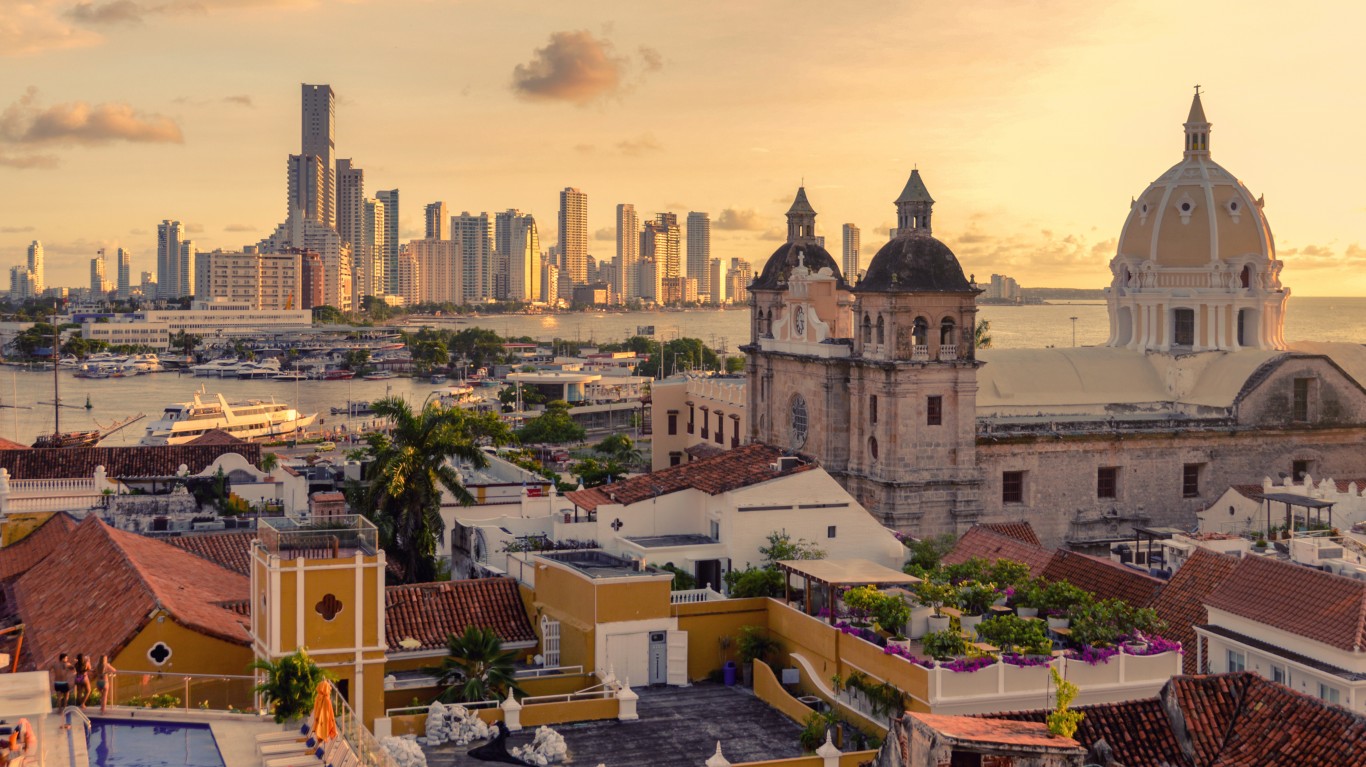
27. Colombia
> Annual deaths due to natural disaster, 1960-2022: 15.5 per million
> Most common natural disaster: Flood (103 incidents since 1900)
> Deadliest disaster since 1900: November 1985 Nevado Del Ruiz ash fall (21,800 deaths)
> Total population: 51.3 million
The Nevado Del Ruiz volcano erupted in November 1985, triggering an avalanche of melted ice and snow. The resulting lahars – a cascade of rock, mud, and water from the eruption – killed more than 20,000 people. The death toll is said to be the fourth largest single-eruption death toll in history.
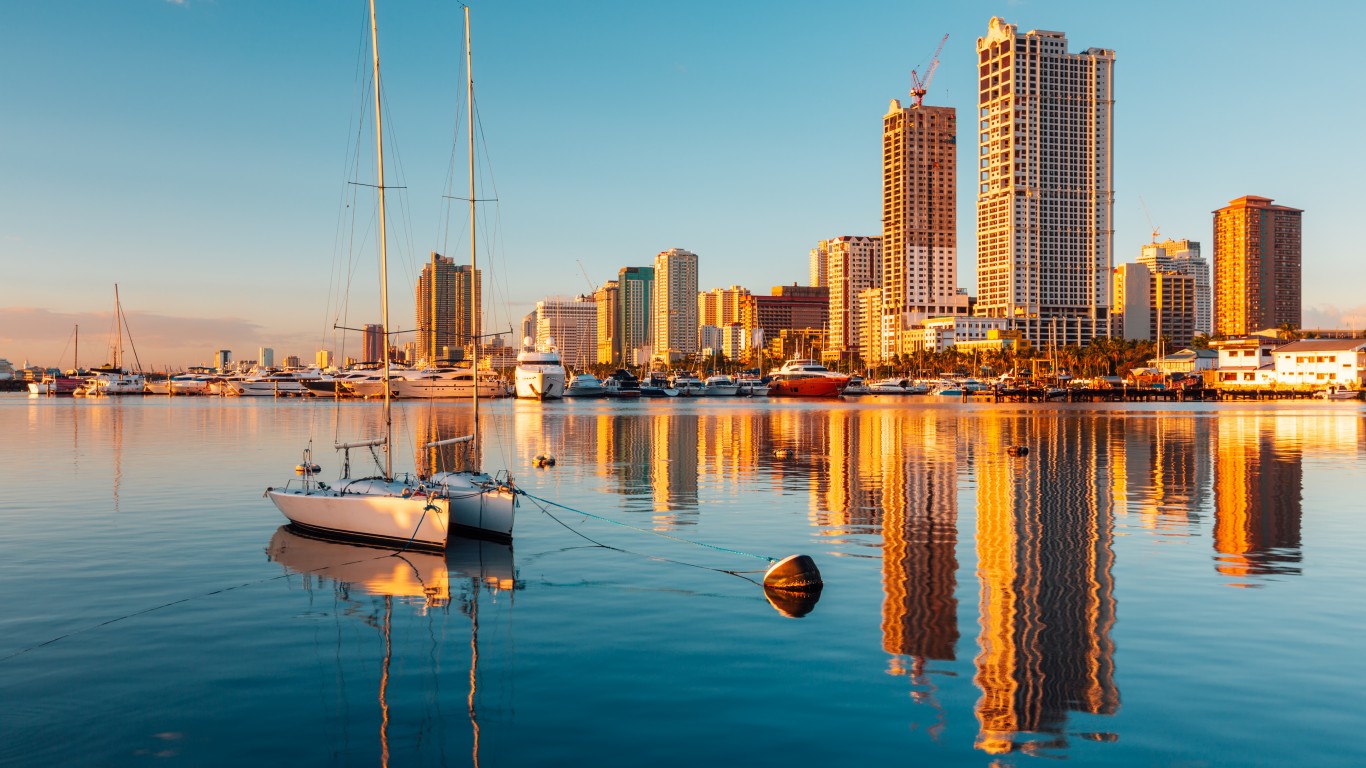
26. Philippines
> Annual deaths due to natural disaster, 1960-2022: 16.2 per million
> Most common natural disaster: Storm (377 incidents since 1900)
> Deadliest disaster since 1900: November 2013 typhoon Haiyan (7,354 deaths)
> Total population: 111.0 million
Typhoon Haiyan, also called Super Typhoon Yolanda in the Philippines, was the fifth named super typhoon of the 2013 Pacific typhoon season. Although the impact was felt throughout Southeast Asia, the Philippines was hardest hit by the Category 5-equivalent super typhoon as measured by Saffir-Simpson hurricane wind scale.
[in-text-ad-2]

25. Niger
> Annual deaths due to natural disaster, 1960-2022: 17.3 per million
> Most common natural disaster: Epidemic (45 incidents since 1900)
> Deadliest disaster since 1900: 1923 bacteria epidemic (100,000 deaths)
> Total population: 25.1 million
Although Niger has weathered 45 epidemics since 1900, the country more recently was hit with an outbreak of highly contagious cholera. In August of last year, Doctors Without Borders reported cholera has sickened more than 4,000 people in the country and killed 144.

24. Indonesia
> Annual deaths due to natural disaster, 1960-2022: 19.3 per million
> Most common natural disaster: Flood (257 incidents since 1900)
> Deadliest disaster since 1900: December 2004 tsunami (165,708 deaths)
> Total population: 276.4 million
The 2004 tsunami impacted several countries in South and Southeast Asia, but Indonesia sustained the most damage. A 9.1 magnitude earthquake off the Indonesian island of Sumatra triggered the titanic waves of the tsunami that killed more than 165,000 in the country.
[in-text-ad]

23. Nepal
> Annual deaths due to natural disaster, 1960-2022: 20.6 per million
> Most common natural disaster: Flood (55 incidents since 1900)
> Deadliest disaster since 1900: April 2015 earthquake (8,831 deaths)
> Total population: 29.7 million
The Himalayan country of Nepal endured one of its worst natural disasters when a 7.8 magnitude earthquake shook the ground around the capital city of Kathmandu. Although the Himalayan region is seismically active, major earthquakes are infrequent in the area.
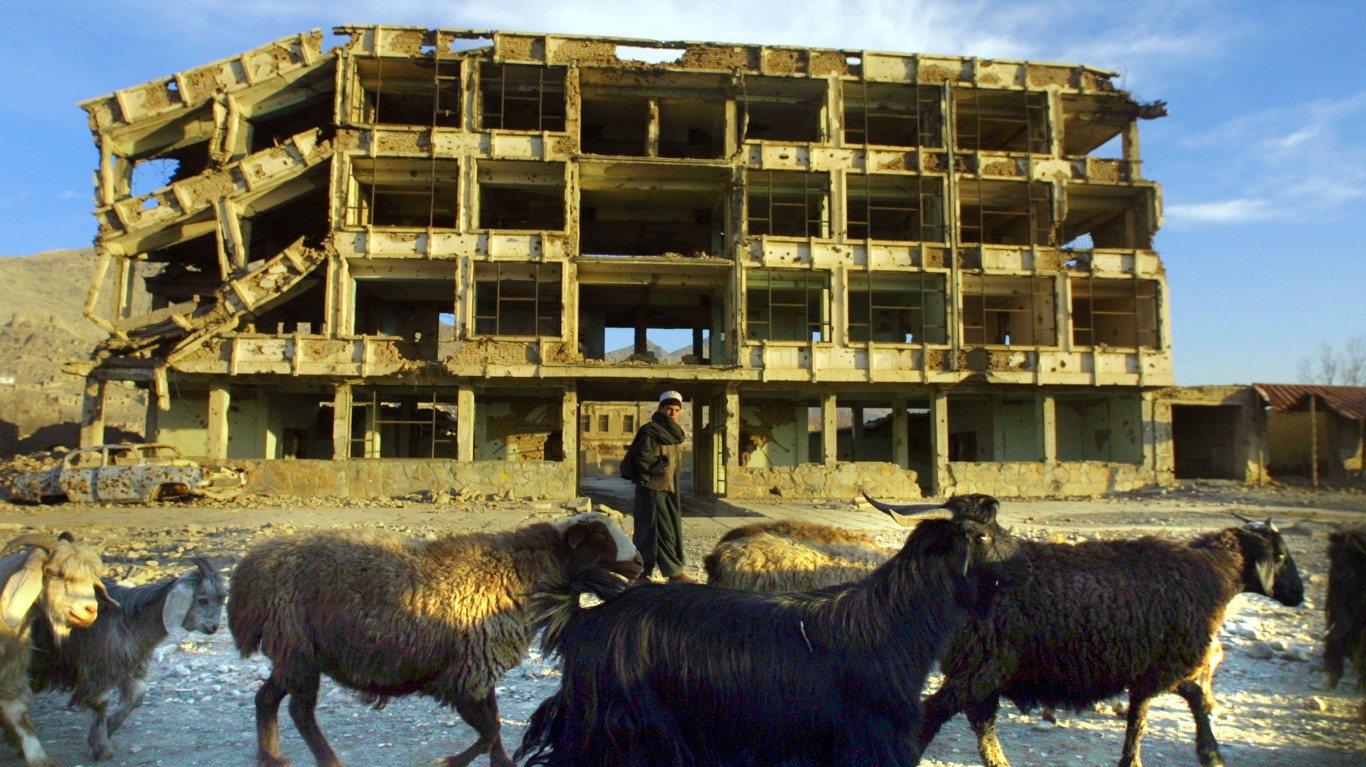
22. Afghanistan
> Annual deaths due to natural disaster, 1960-2022: 20.6 per million
> Most common natural disaster: Flood (99 incidents since 1900)
> Deadliest disaster since 1900: May 1998 earthquake (4,700 deaths)
> Total population: 39.8 million
Hitting a remote, mountainous region of Afghanistan, the May 1998 quake magnitude was estimated at 6.9 by the U.S. Geological Survey. It was preceded by another strong earthquake in the same country in February. At the time, the area where the quake struck was held by forces opposed to the Taliban.

21. Chad
> Annual deaths due to natural disaster, 1960-2022: 22.7 per million
> Most common natural disaster: Epidemic (23 incidents since 1900)
> Deadliest disaster since 1900: November 1981 drought (3,000 deaths)
> Total population: 16.9 million
Repeated epidemics and droughts have plagued Chad for decades. With Lake Chad, one of the continent’s largest freshwater bodies, shrinking by 90%, the drought crisis continues, according to a report in Down to Earth. The lake provides water, irrigation, and other economic benefits to the countries of Chad, Niger, Nigeria, and Cameroon.
[in-text-ad-2]
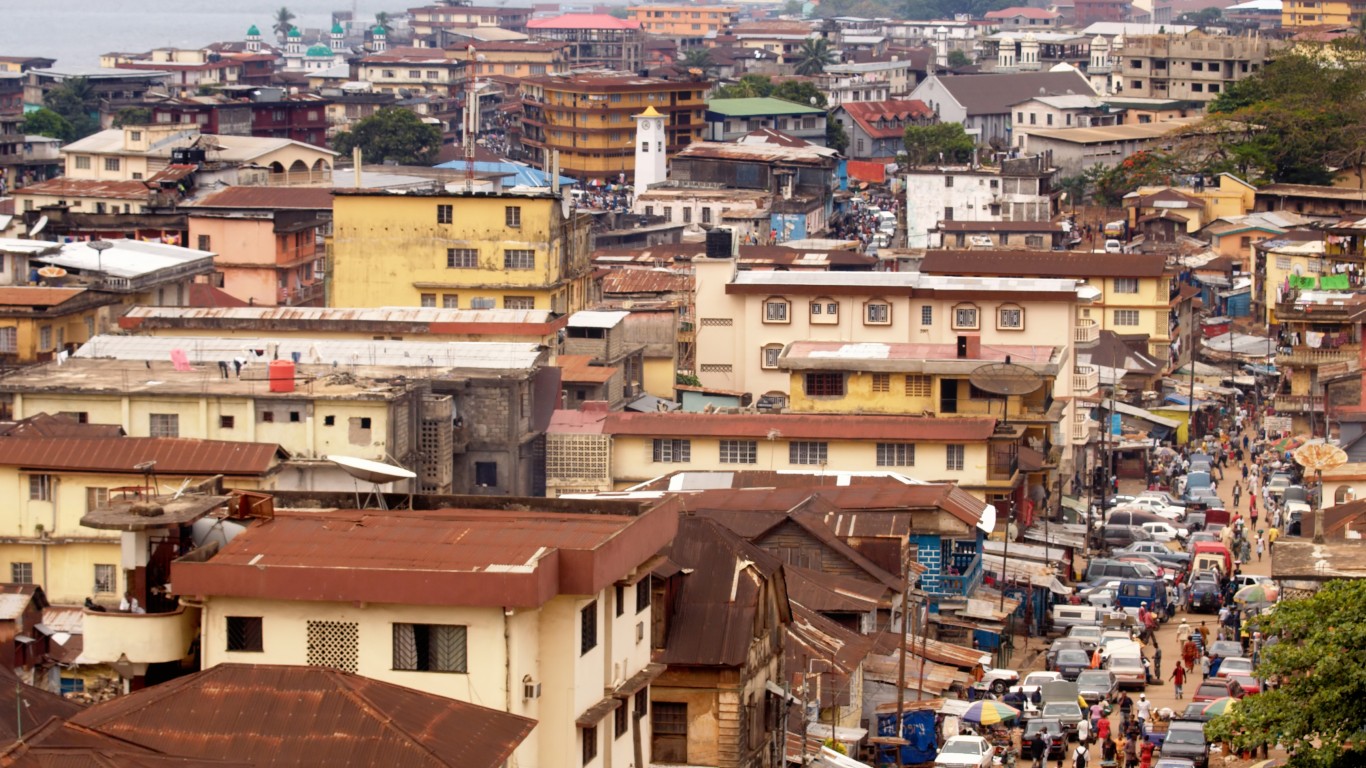
20. Sierra Leone
> Annual deaths due to natural disaster, 1960-2022: 24.2 per million
> Most common natural disaster: Epidemic (16 incidents since 1900)
> Deadliest disaster since 1900: March 2014 ebola epidemic (3,956 deaths)
> Total population: 8.1 million
In March 2014, an outbreak of ebola spread throughout West Africa, including the countries of Guinea, Sierra Leone, and Liberia. The epidemic was declared over in 2016.

19. Venezuela
> Annual deaths due to natural disaster, 1960-2022: 25.5 per million
> Most common natural disaster: Flood (37 incidents since 1900)
> Deadliest disaster since 1900: December 1999 flash flood (30,000 deaths)
> Total population: 28.7 million
The Vargas tragedy, which struck the Vargas State of Venezuela with flash flood waters and debris, is said to have killed about 10% of the state’s population. Between Dec. 14-16, 1999, nearly 36 inches of rain swamped the region, and that was on top of an earlier storm that poured down 7.9 inches of rain.
[in-text-ad]
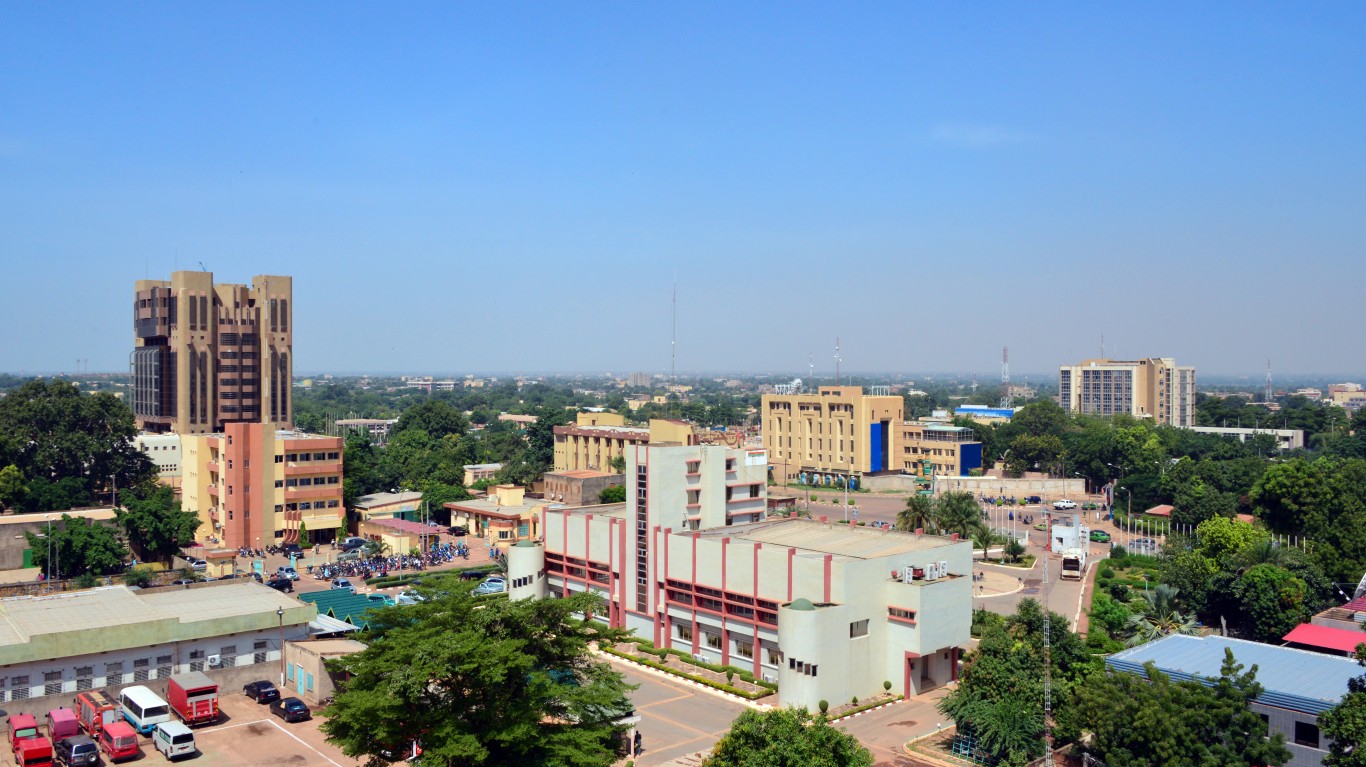
18. Burkina Faso
> Annual deaths due to natural disaster, 1960-2022: 26.9 per million
> Most common natural disaster: Epidemic (25 incidents since 1900)
> Deadliest disaster since 1900: February 1996 bacterial disease (4,071 deaths)
> Total population: 21.5 million
The West African country of Burkina Faso resides in what the Centers for Disease Control and Prevention terms the “meningitis belt,” an area where a number of African countries weather recurrent meningitis epidemics. The dry, windy climate of the land makes it a breeding ground for meningitis.
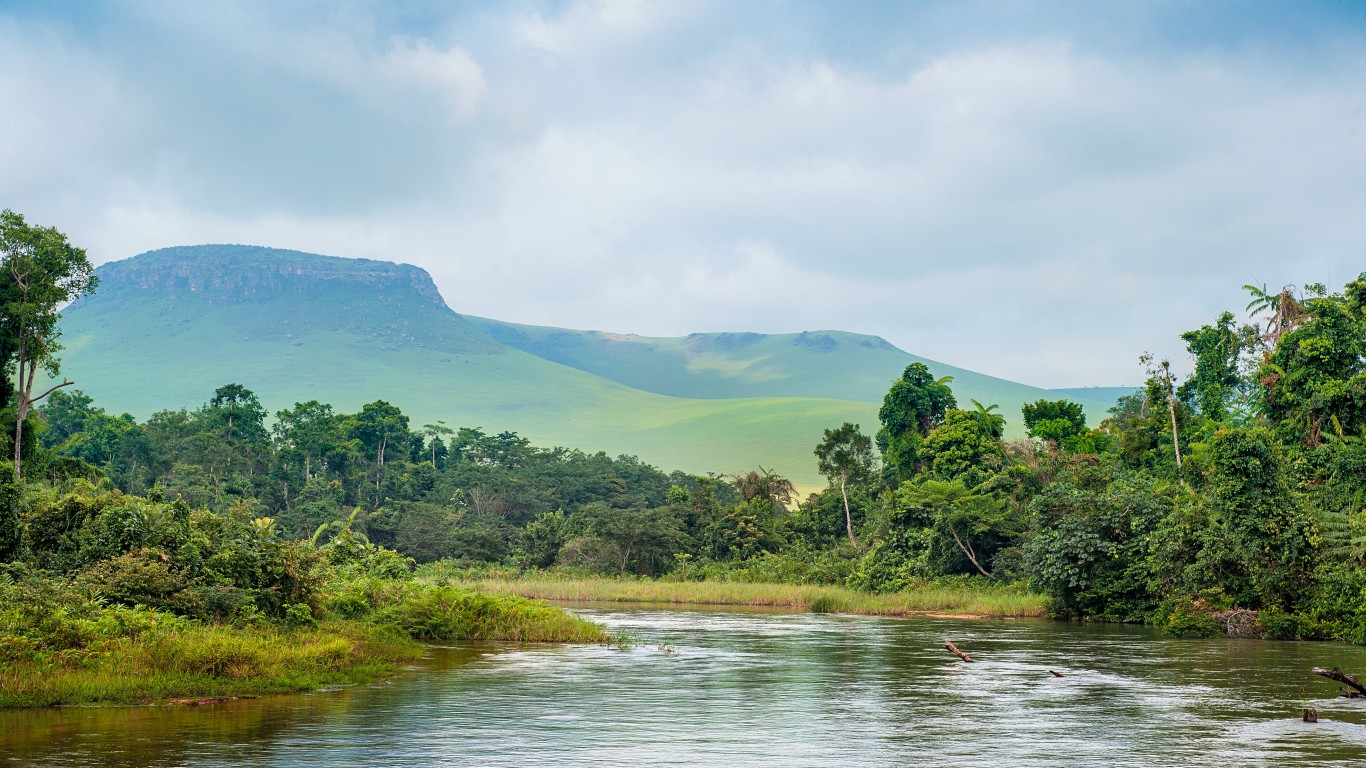
17. Congo
> Annual deaths due to natural disaster, 1960-2022: 28.0 per million
> Most common natural disaster: Epidemic (19 incidents since 1900)
> Deadliest disaster since 1900: January 2019 viral disease (3,559 deaths)
> Total population: 5.7 million
The ebola outbreak in the Democratic Republic of the Congo was first declared in 2018 and persisted until January 2019. UNICEF said it was the country’s 10th ebola epidemic and its worst.

16. India
> Annual deaths due to natural disaster, 1960-2022: 31.0 per million
> Most common natural disaster: Flood (317 incidents since 1900)
> Deadliest disaster since 1900: 1920 bubonic epidemic (2,000,000 deaths)
> Total population: 1.4 billion
The bubonic plague ravaged Europe in the 14th century, but in 1896 the disease devastated the city of Bombay, or modern day Mumbai. Infections are linked to fleas that cling to rodents and infect humans. With better understanding of how the disease spread and by controlling the rat population, the epidemic was brought under control by the early 1920s. But that was after 2 million died.
[in-text-ad-2]

15. Liberia
> Annual deaths due to natural disaster, 1960-2022: 34.9 per million
> Most common natural disaster: Epidemic (13 incidents since 1900)
> Deadliest disaster since 1900: March 2014 viral disease (4,810 deaths)
> Total population: 5.2 million
The ebola outbreak in Liberia began in March 2014 with the first confirmed cases in the country’s Lofa County. By May and June, the epidemic intensified, leading to 10,672 cases and 4,810 deaths. By May 2015, the epidemic was declared over.
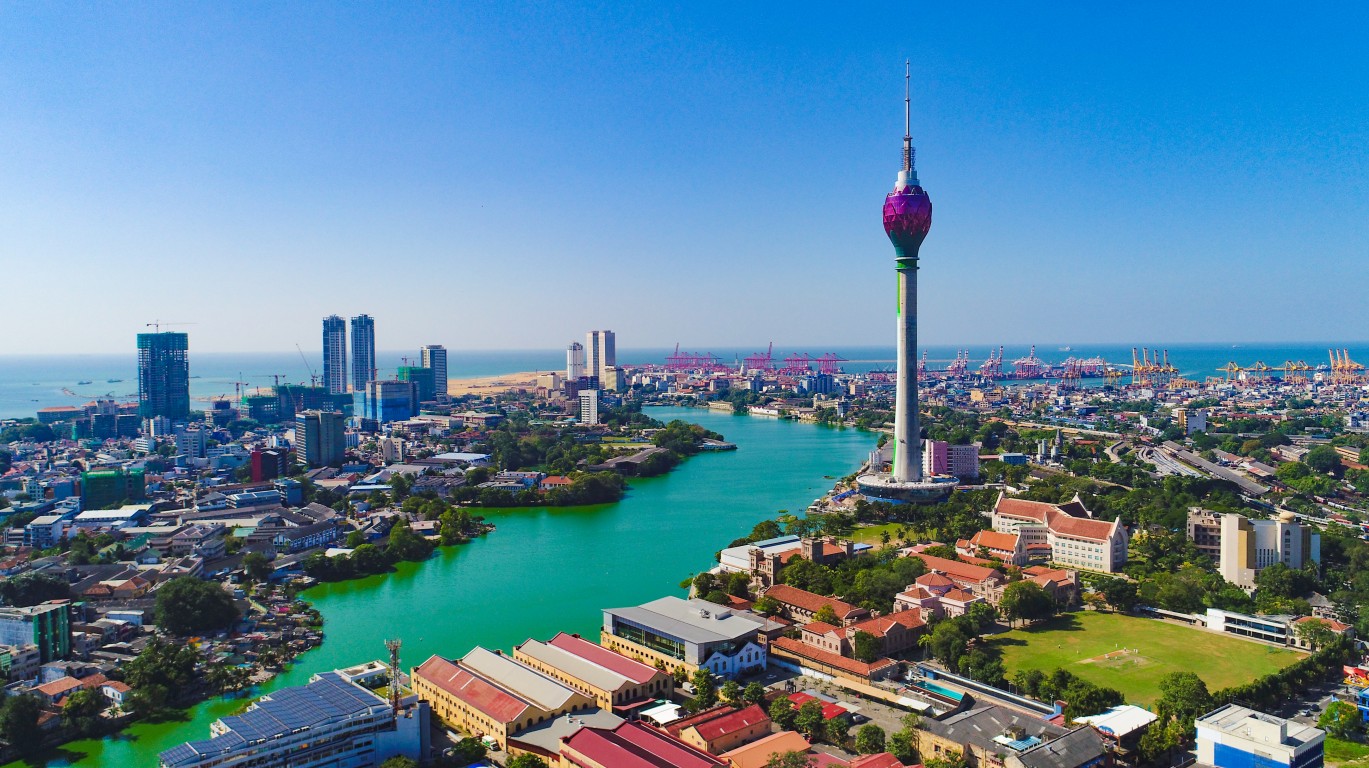
14. Sri Lanka
> Annual deaths due to natural disaster, 1960-2022: 38.5 per million
> Most common natural disaster: Flood (78 incidents since 1900)
> Deadliest disaster since 1900: December 2004 tsunami (35,399 deaths)
> Total population: 22.2 million
An earthquake under the Indian Ocean on Dec. 26, 2004 hit Sri Lanka with a massive tsunami, leading to more than 35,000 deaths. In the aftermath of the tsunami, infectious diseases spread, resulting in more deaths from cholera.
[in-text-ad]

13. Iran
> Annual deaths due to natural disaster, 1960-2022: 41.1 per million
> Most common natural disaster: Earthquake (133 incidents since 1900)
> Deadliest disaster since 1900: June 1990 earthquake (40,000 deaths)
> Total population: 85.0 million
One of the world’s most devastating earthquakes was recorded in June 1990 in Northern Iran. One reason for the high death toll was because Iranians were in their homes watching the 1990 FIFA World Cup.

12. Guinea-Bissau
> Annual deaths due to natural disaster, 1960-2022: 44.8 per million
> Most common natural disaster: Epidemic (8 incidents since 1900)
> Deadliest disaster since 1900: October 1996 bacterial disease (961 deaths)
> Total population: 2.0 million
Sub-Saharan countries like Guinea-Bissau continually battle cholera outbreaks. Heavy rainfalls along with higher sea and air temperatures contribute to the conditions where cholera bacteria can thrive. One of the worst outbreaks occurred in October 1996, leading to the deaths of 961 people.
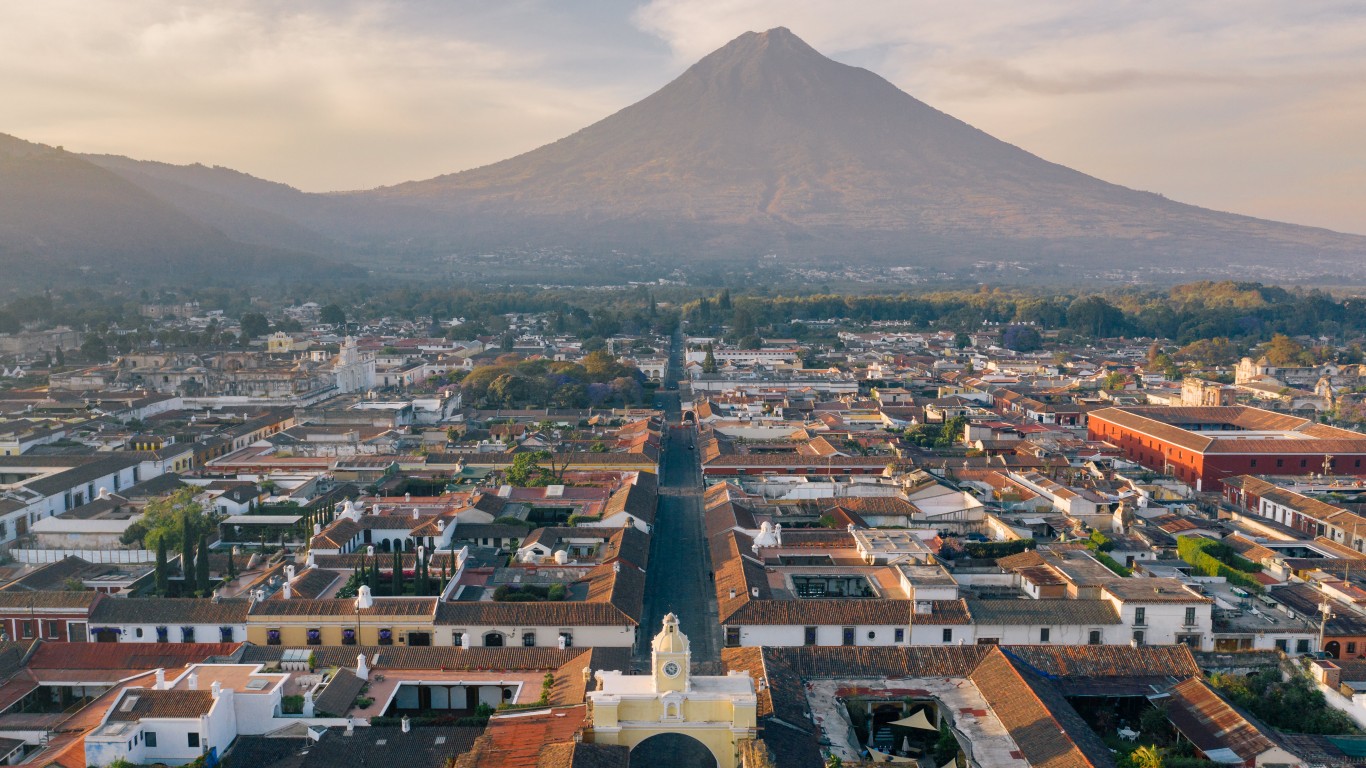
11. Guatemala
> Annual deaths due to natural disaster, 1960-2022: 47.1 per million
> Most common natural disaster: Flood (37 incidents since 1900)
> Deadliest disaster since 1900: October 1949 flood (40,000 deaths)
> Total population: 17.1 million
In October 1949, the Central American country withstood 72 hours of heavy rains. The resulting floods caused some 40,000 deaths, making it one of the deadliest floods in history.
[in-text-ad-2]
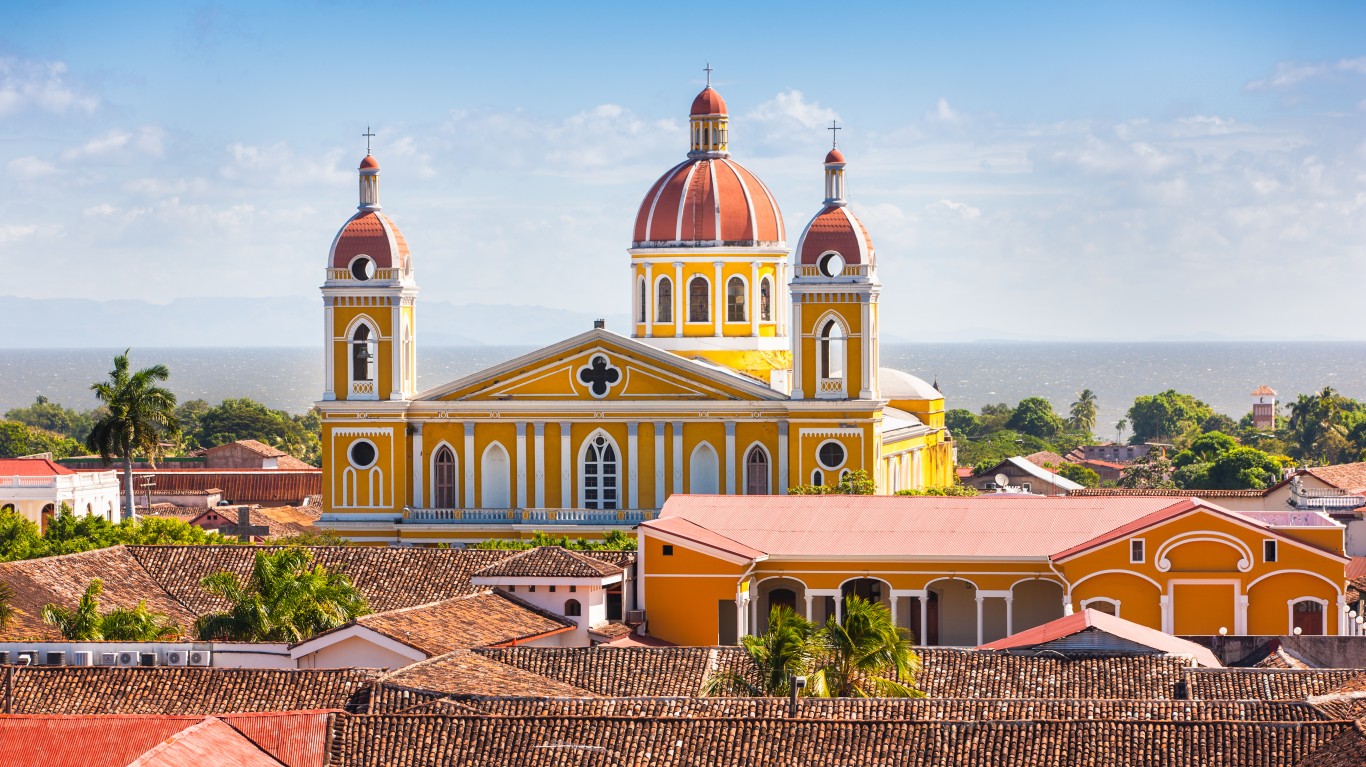
10. Nicaragua
> Annual deaths due to natural disaster, 1960-2022: 56.9 per million
> Most common natural disaster: Storm (25 incidents since 1900)
> Deadliest disaster since 1900: December 1972 earthquake (10,000 deaths)
> Total population: 6.7 million
In December 1972, an earthquake with an estimated magnitude of 7.6 struck the Pacific Coast of Nicaragua. In addition to a high death toll, the resulting tsunami destroyed most of the country’s fishing fleet. In 1972, the capital city of Managua was hit by another devastating earthquake. While trying to bring aid to the country after that disaster, baseball star Roberto Clemente died when his plane went down in the sea.
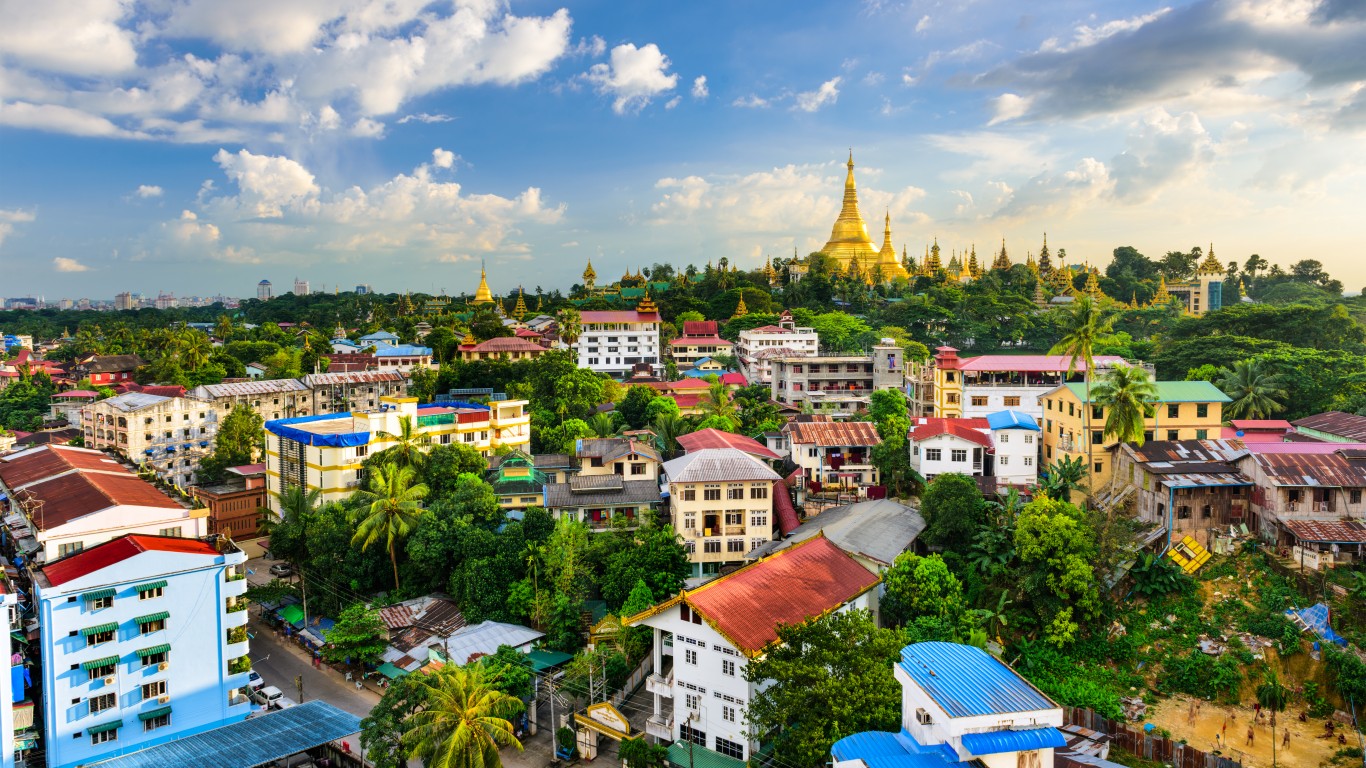
9. Myanmar
> Annual deaths due to natural disaster, 1960-2022: 57.3 per million
> Most common natural disaster: Flood (36 incidents since 1900)
> Deadliest disaster since 1900: May 2008 tropical cyclone (138,366 deaths)
> Total population: 54.8 million
Known as Cyclone Nargis, the storm made landfall in Myanmar in May 2008, remaining over the country for two days. The cyclone left 138,366 dead and affected more than 2.4 million people.
[in-text-ad]

8. Peru
> Annual deaths due to natural disaster, 1960-2022: 66.2 per million
> Most common natural disaster: Flood (70 incidents since 1900)
> Deadliest disaster since 1900: May 1970 earthquake (66,794 deaths)
> Total population: 33.4 million
Destructive landslides followed the 1970 Peruvian earthquake, killing more than 66,000. The town of Yungay was swamped when a wall of ice was dislodged from the country’s highest mountain, Mount Huascarán. The earthquake was measured at a magnitude of 7.9.
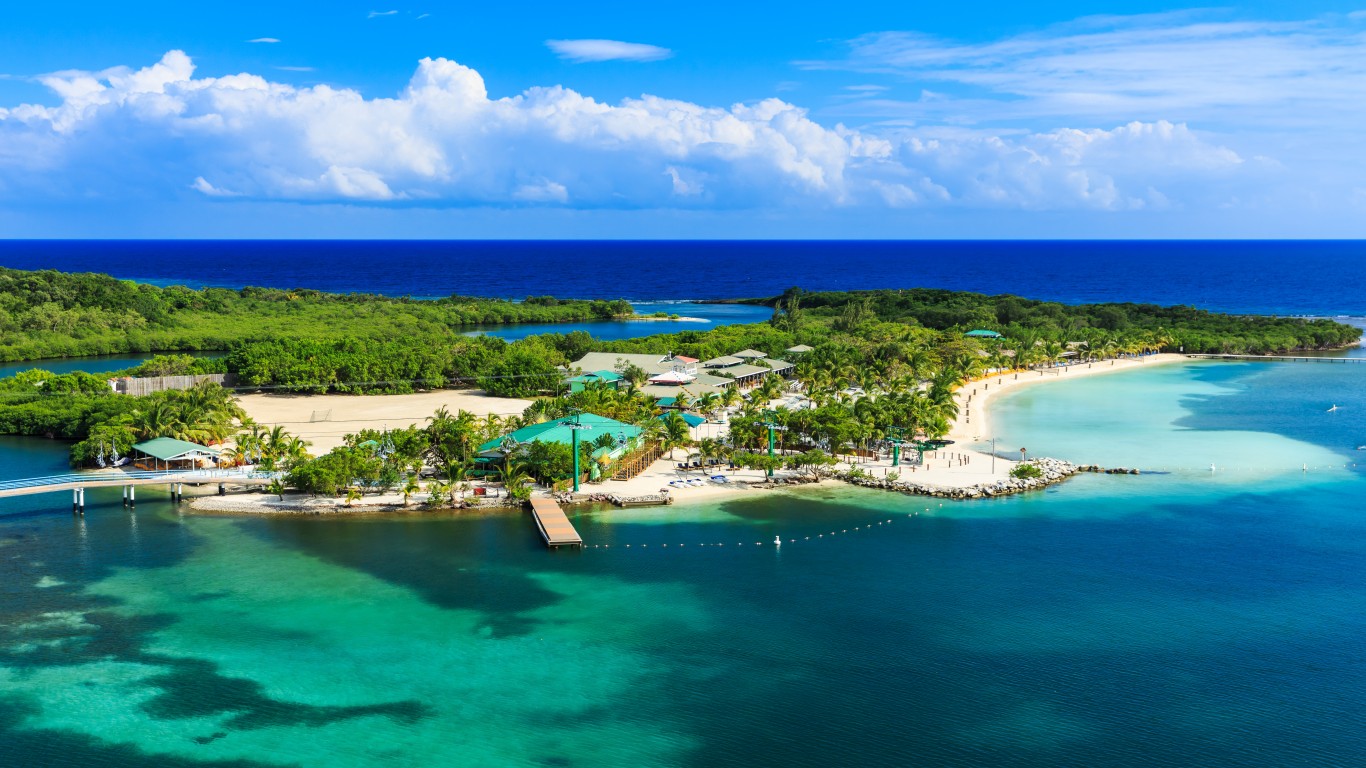
7. Honduras
> Annual deaths due to natural disaster, 1960-2022: 81.0 per million
> Most common natural disaster: Flood (38 incidents since 1900)
> Deadliest disaster since 1900: October 1998 tropical cyclone (14,600 deaths)
> Total population: 10.1 million
The October 1998 tropical cyclone that hit this Central American country was also named Hurricane Mitch. At its peak, the storm reached Category 5 status, the highest on the Saffir-Simpson scale, with winds reaching 180 miles per hour. The resulting mud slides, floods, and winds destroyed the country’s infrastructure, crops, and major population centers.

6. Bangladesh
> Annual deaths due to natural disaster, 1960-2022: 96.8 per million
> Most common natural disaster: Storm (182 incidents since 1900)
> Deadliest disaster since 1900: 1943 drought (1,900,000 deaths)
> Total population: 166.3 million
Northwest Bangladesh is prone to frequent droughts. Dependent on rainfall for drinking water and crop production, severe droughts in these areas often lead to famine. The Bengal famine of 1943 in which over a million people died (estimates go as high as 3 million) was partly brought on by crop failure due to drought, though policy reasons are mostly blamed today. The Bengal region at the time was under British rule and included present-day Bangladesh.
[in-text-ad-2]

5. Somalia
> Annual deaths due to natural disaster, 1960-2022: 102.6 per million
> Most common natural disaster: Flood (47 incidents since 1900)
> Deadliest disaster since 1900: February 2010 drought (20,000 deaths)
> Total population: 16.4 million
Between 2010 and 2012, a devastating drought hit Somalia, killing 260,000 people, half of whom were children under age 5, the UN reported. Fighting between rival groups in the country exacerbated the crisis.
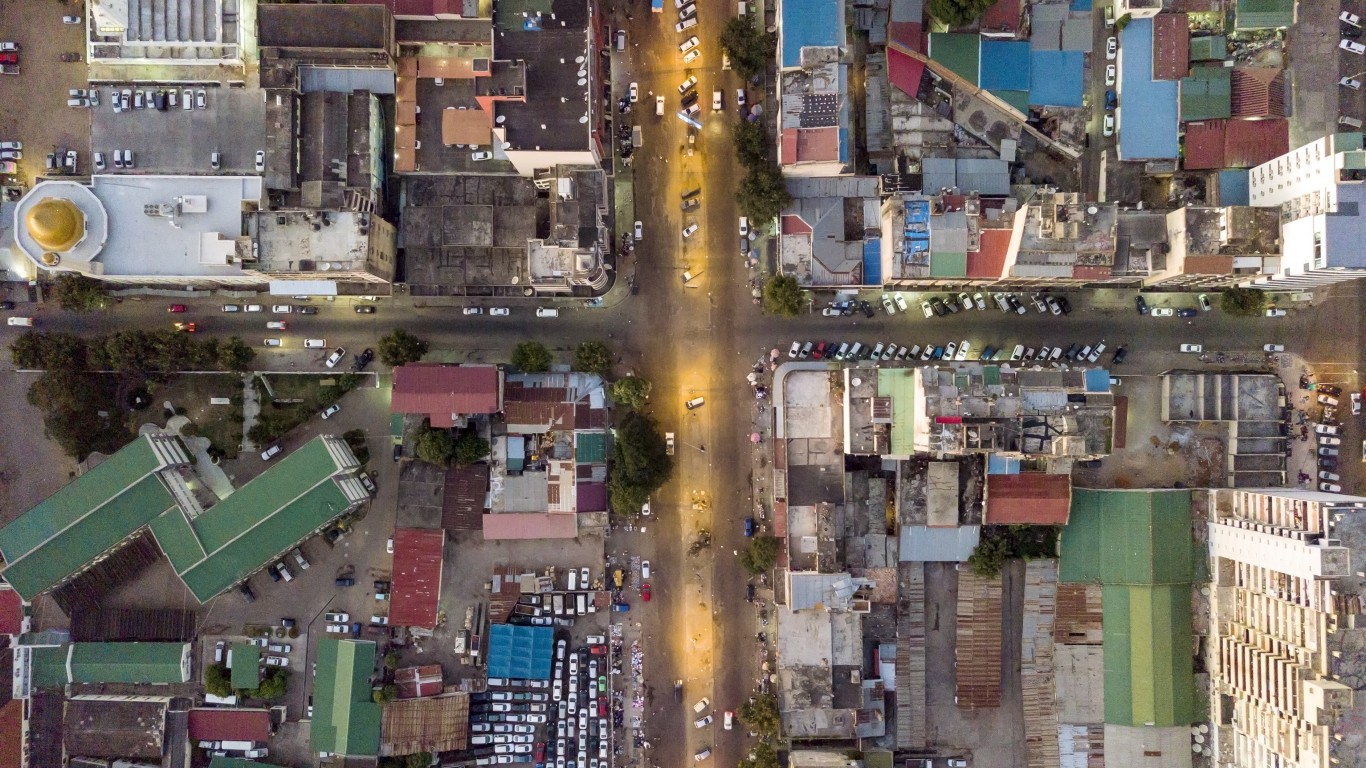
4. Mozambique
> Annual deaths due to natural disaster, 1960-2022: 108.1 per million
> Most common natural disaster: Flood (42 incidents since 1900)
> Deadliest disaster since 1900: 1981 drought (100,000 deaths)
> Total population: 32.2 million
Starting in 1981 through 1985, a severe drought in Mozambique not only led to 100,000 deaths, but significantly decreased crop production. A cholera epidemic spread though several drought-stricken provinces as well.
[in-text-ad]

3. Sudan
> Annual deaths due to natural disaster, 1960-2022: 116.8 per million
> Most common natural disaster: Epidemic (43 incidents since 1900)
> Deadliest disaster since 1900: April 1983 drought (150,000 deaths)
> Total population: 44.9 million
Sudan’s rainy season typically stretches from June to September. But starting in 1980, annual rainfall fell short, leading to drought conditions by mid-1983. Without rain, agricultural outputs decreased by as much as half.
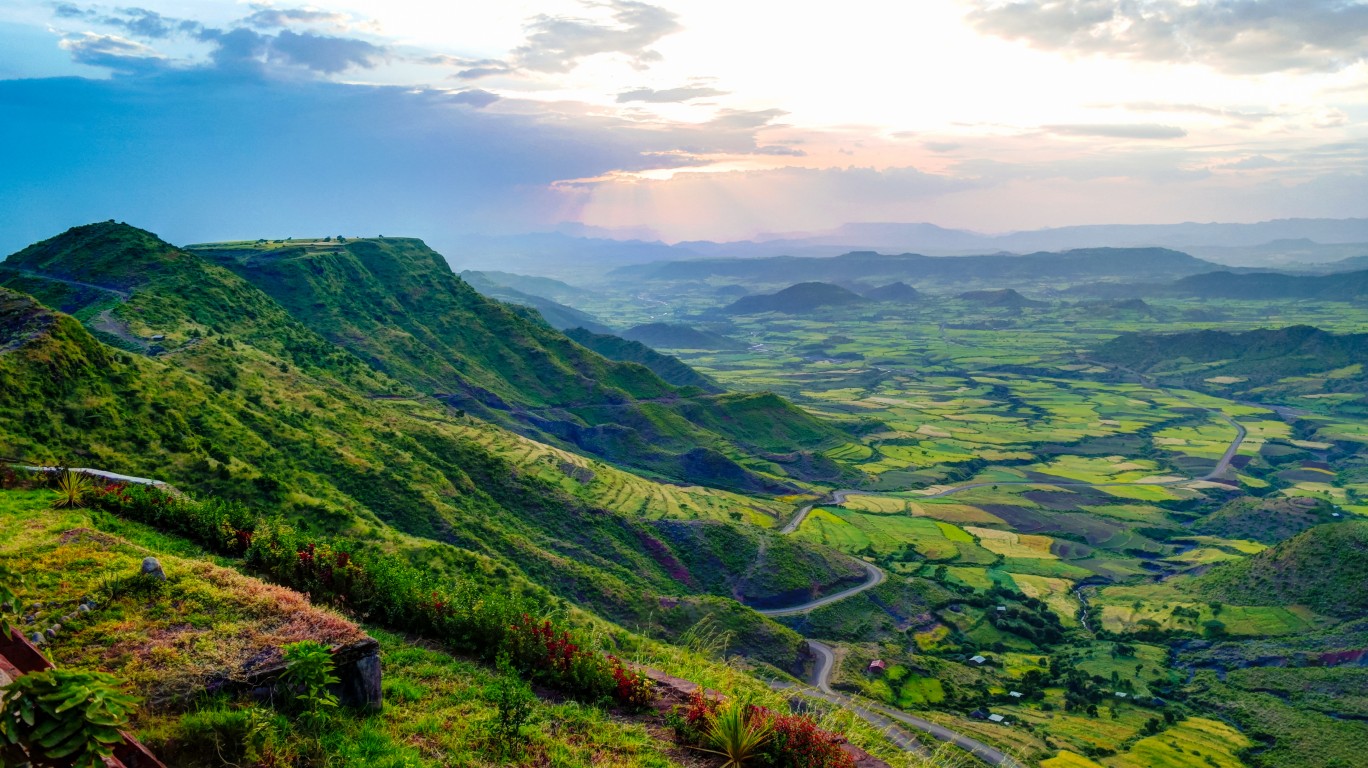
2. Ethiopia
> Annual deaths due to natural disaster, 1960-2022: 118.6 per million
> Most common natural disaster: Flood (58 incidents since 1900)
> Deadliest disaster since 1900: May 1983 drought (300,000 deaths)
> Total population: 117.9 million
Droughts often trigger widespread famine, and in Ethiopia in the early 1980s, lack of rain caused food shortages and hunger in the African nation. Conflicts between warring factions hampered aid efforts at the time.
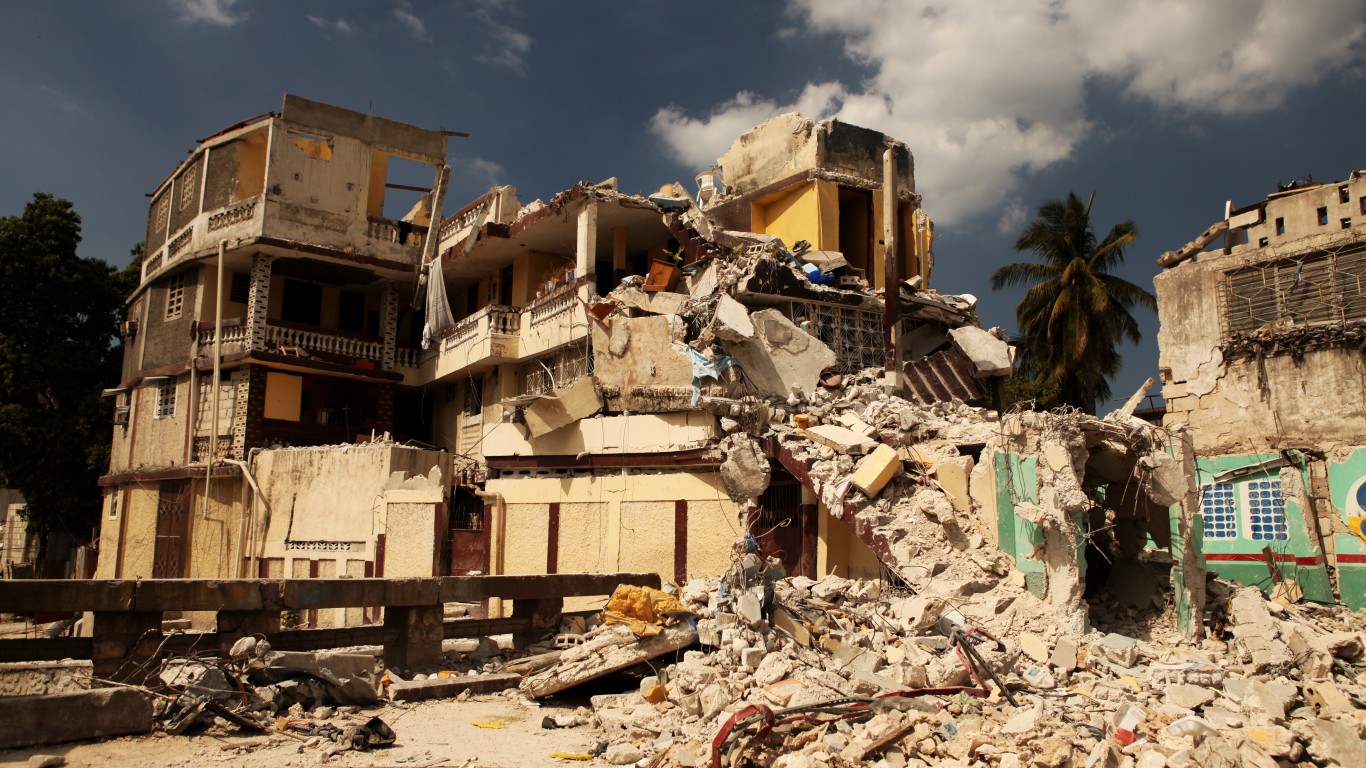
1. Haiti
> Annual deaths due to natural disaster, 1960-2022: 547.8 per million
> Most common natural disaster: Flood (64 incidents since 1900)
> Deadliest disaster since 1900: January 2010 earthquake (222,570 deaths)
> Total population: 11.5 million
One of the worst natural disasters to hit the Western Hemisphere occured in Haiti in 2010. An earthquake recorded at a 7.0 magnitude was followed by two aftershocks of 5.9 and 5.5 magnitudes. The quake devastated the capital city of Port-au-Prince, with many buildings crumbling due to weak building codes. The quake struck at a time when the country was still struggling to recover from two hurricanes in 2008.
Want retirement to come a few years earlier than you’d planned? Or are you ready to retire now, but want an extra set of eyes on your finances?
Now you can speak with up to 3 financial experts in your area for FREE. By simply clicking here you can begin to match with financial professionals who can help you build your plan to retire early. And the best part? The first conversation with them is free.
Click here to match with up to 3 financial pros who would be excited to help you make financial decisions.
Thank you for reading! Have some feedback for us?
Contact the 24/7 Wall St. editorial team.